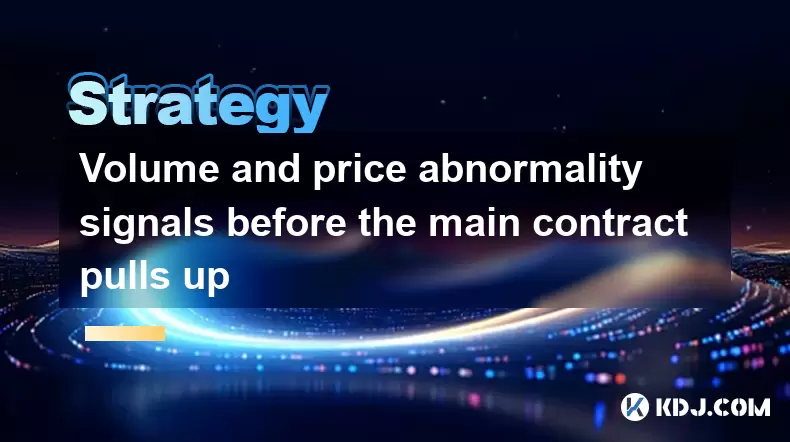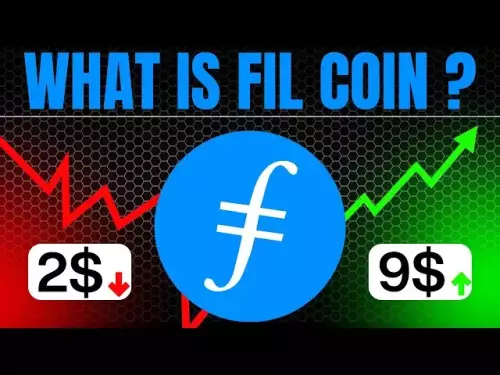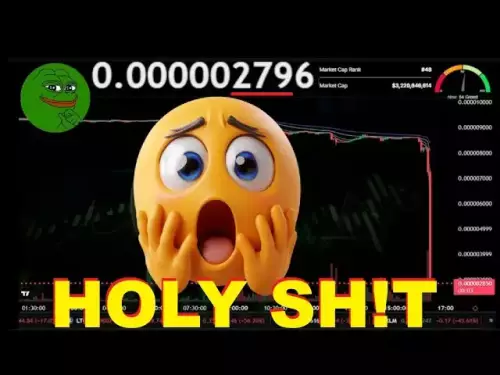-
 bitcoin
bitcoin $111375.742210 USD
-8.60% -
 ethereum
ethereum $3780.311592 USD
-13.98% -
 tether
tether $1.001299 USD
0.07% -
 bnb
bnb $1093.375857 USD
-13.01% -
 xrp
xrp $2.339375 USD
-16.91% -
 solana
solana $185.029017 USD
-16.69% -
 usd-coin
usd-coin $1.000230 USD
0.04% -
 tron
tron $0.319531 USD
-5.16% -
 dogecoin
dogecoin $0.190791 USD
-23.59% -
 cardano
cardano $0.638663 USD
-21.82% -
 ethena-usde
ethena-usde $0.998483 USD
-0.20% -
 hyperliquid
hyperliquid $37.741486 USD
-14.68% -
 chainlink
chainlink $17.229851 USD
-22.17% -
 stellar
stellar $0.316546 USD
-16.74% -
 bitcoin-cash
bitcoin-cash $507.861193 USD
-13.18%
Volume and price abnormality signals before the main contract pulls up
Volume spikes, price consolidation, and order book imbalances often signal an impending main contract pull-up in crypto markets, enhanced by technical indicators and market sentiment.
Jun 01, 2025 at 02:01 pm

Understanding the dynamics of volume and price in cryptocurrency markets is crucial for traders looking to anticipate significant movements in the main contract. By recognizing specific signals, traders can position themselves advantageously before a major price surge occurs. This article delves into the various volume and price abnormality signals that often precede a main contract pull-up in the crypto market.
Identifying Volume Spikes
One of the most critical indicators that a main contract might be about to pull up is a significant increase in trading volume. Volume spikes can signal a growing interest in a particular asset, often preceding a price movement.
- Monitor trading volume charts closely. Look for sudden increases that deviate from the average trading volume over the past few days or weeks.
- Compare current volume levels with historical data. A volume spike that exceeds typical levels by a substantial margin may indicate that a major price movement is imminent.
- Pay attention to volume patterns in conjunction with price movements. If volume spikes occur alongside a gradual increase in price, it could be a precursor to a more significant upward movement.
Analyzing Price Consolidation Phases
Before a main contract pulls up, the price often enters a consolidation phase. During this period, the price moves within a relatively tight range, reflecting a balance between buying and selling pressures.
- Observe the price range over a period of time. If the price consolidates within a narrow band for an extended period, it may be building up energy for a breakout.
- Look for signs of decreasing volatility. A decrease in price fluctuations within the consolidation phase can be a signal that a significant move is on the horizon.
- Track the formation of chart patterns, such as triangles or flags. These patterns often precede breakouts and can provide clues about the direction of the impending price movement.
Spotting Unusual Price Movements
Unusual price movements, such as sudden spikes or dips, can also serve as signals that the main contract is about to pull up. These movements often reflect shifts in market sentiment and can precede larger trends.
- Watch for rapid price changes that occur without corresponding news or events. These movements may indicate that large traders or institutions are positioning themselves for a significant move.
- Analyze the context of the price movement. If a sudden price spike occurs after a period of consolidation, it could be a signal that the main contract is about to pull up.
- Consider the volume accompanying the price movement. High volume during an unusual price movement reinforces the signal that a major price shift is likely.
Monitoring Order Book Dynamics
The order book provides valuable insights into market sentiment and can signal an impending pull-up in the main contract. By analyzing the depth and distribution of buy and sell orders, traders can gauge the strength of potential price movements.
- Examine the order book for imbalances. A significant number of buy orders at higher price levels compared to sell orders can indicate strong buying interest and potential for an upward price movement.
- Look for large orders. The presence of large buy orders in the order book can signal that institutional investors are preparing for a price increase.
- Track changes in the order book over time. Rapid shifts in the order book, such as the sudden appearance of large buy orders, can be a precursor to a main contract pull-up.
Utilizing Technical Indicators
Technical indicators can provide additional confirmation of volume and price abnormality signals. By integrating these tools into their analysis, traders can enhance their ability to predict main contract pull-ups.
- Use the Relative Strength Index (RSI). An RSI value that moves from an oversold condition towards overbought territory can indicate that a price increase is imminent.
- Implement the Moving Average Convergence Divergence (MACD). A bullish crossover in the MACD, where the MACD line crosses above the signal line, can signal a potential upward price movement.
- Apply the Bollinger Bands. A price breakout above the upper Bollinger Band, especially when accompanied by a volume spike, can be a strong signal that the main contract is about to pull up.
Interpreting Market Sentiment
Market sentiment plays a crucial role in the cryptocurrency market and can significantly influence volume and price movements. By gauging the overall sentiment, traders can better anticipate when a main contract might pull up.
- Monitor social media and forums. A surge in positive sentiment and discussions around a particular cryptocurrency can precede a price increase.
- Analyze sentiment indicators. Tools like the Fear and Greed Index can provide insights into market sentiment and help traders anticipate potential price movements.
- Consider the impact of news and events. Positive news or developments related to a cryptocurrency can boost market sentiment and lead to a main contract pull-up.
Combining Multiple Signals
To increase the accuracy of predicting a main contract pull-up, traders should combine multiple signals. By integrating volume, price, order book, technical indicators, and market sentiment data, traders can build a more comprehensive picture of market conditions.
- Cross-reference volume spikes with price consolidation. A volume spike following a consolidation phase can be a strong indicator of an impending price increase.
- Integrate technical indicators with order book analysis. A bullish MACD crossover combined with a significant imbalance in the order book can reinforce the likelihood of a main contract pull-up.
- Factor in market sentiment. Positive sentiment, especially when accompanied by other signals, can increase the confidence in predicting a price surge.
Frequently Asked Questions
1. How can traders differentiate between a false signal and a genuine precursor to a main contract pull-up?Traders can differentiate between false signals and genuine precursors by looking for consistency across multiple indicators. If volume spikes, price consolidation, and technical indicators all align, the likelihood of a genuine signal increases. Additionally, monitoring the market over a longer period can help identify patterns that are more likely to lead to a main contract pull-up.
2. Are there specific times of the day or week when volume and price abnormalities are more likely to signal a main contract pull-up?While there is no definitive answer, traders often observe increased volatility and volume during major market sessions, such as the overlap of the Asian and European sessions or the start of the US trading session. These periods can be more conducive to significant price movements and, consequently, main contract pull-ups.
3. Can external factors, such as regulatory news, impact the reliability of volume and price abnormality signals?Yes, external factors like regulatory news can significantly impact market dynamics. Positive regulatory news can amplify volume and price signals, increasing the likelihood of a main contract pull-up. Conversely, negative news can dampen these signals and lead to false positives. Traders should always consider the broader context when interpreting volume and price abnormalities.
4. How can traders use historical data to improve their ability to predict main contract pull-ups based on volume and price signals?Traders can use historical data to identify patterns and correlations between volume and price movements that have preceded main contract pull-ups in the past. By backtesting strategies and analyzing historical charts, traders can refine their approach and increase the accuracy of their predictions based on current volume and price signals.
Disclaimer:info@kdj.com
The information provided is not trading advice. kdj.com does not assume any responsibility for any investments made based on the information provided in this article. Cryptocurrencies are highly volatile and it is highly recommended that you invest with caution after thorough research!
If you believe that the content used on this website infringes your copyright, please contact us immediately (info@kdj.com) and we will delete it promptly.
- Bittensor (TAO): Super Bullish Signals Point to Potential 2x Rally
- 2025-10-11 10:25:12
- Silver Price Correction: Navigating the Dip & Identifying Key SEO Keywords
- 2025-10-11 10:25:12
- MoonBull: The Crypto Meme Coin Promising 1000x Gains?
- 2025-10-11 10:30:01
- Crypto Payroll Revolution: Stablecoins, Altcoins, and the Future of Salary Payments
- 2025-10-11 10:30:01
- Decoding Crypto Trends: XRP's Bitcoin Dream, BlockDAG's Rise, and the PayFi Revolution
- 2025-10-11 10:30:01
- Amina Bank & Polygon: Institutional Staking with a Sweet 15% Yield
- 2025-10-11 10:30:15
Related knowledge

Practical parameter settings for a Bitcoin multi-timeframe moving average system
Sep 18,2025 at 10:54pm
Optimizing Timeframe Combinations for Bitcoin Trading1. Selecting appropriate timeframes is crucial when building a multi-timeframe moving average sys...

How can I filter out false breakouts in Dogecoin high-frequency trading?
Sep 22,2025 at 01:00am
Understanding False Breakouts in Dogecoin Trading1. A false breakout occurs when Dogecoin's price appears to move beyond a defined support or resistan...

Techniques for identifying tops and bottoms in the Bitcoin on-chain NVT model
Sep 20,2025 at 07:54pm
Understanding the NVT Model in Bitcoin Analysis1. The Network Value to Transactions (NVT) ratio is often described as the 'P/E ratio' of the cryptocur...

What does the surge in open interest in Bitcoincoin futures mean?
Sep 20,2025 at 11:18pm
Understanding the Surge in Dogecoin Futures Open Interest1. A surge in open interest within Dogecoin futures indicates a growing number of active cont...

How can I use the Ethereum USDT premium to gauge market sentiment?
Sep 18,2025 at 11:55pm
Understanding the Ethereum USDT Premium1. The Ethereum USDT premium refers to the price difference between USDT (Tether) traded on Ethereum-based plat...

What should I do if Ethereum staking yields decline?
Sep 20,2025 at 06:18am
Understanding the Causes Behind Declining Ethereum Staking Yields1. The Ethereum network transitioned to a proof-of-stake consensus mechanism with the...

Practical parameter settings for a Bitcoin multi-timeframe moving average system
Sep 18,2025 at 10:54pm
Optimizing Timeframe Combinations for Bitcoin Trading1. Selecting appropriate timeframes is crucial when building a multi-timeframe moving average sys...

How can I filter out false breakouts in Dogecoin high-frequency trading?
Sep 22,2025 at 01:00am
Understanding False Breakouts in Dogecoin Trading1. A false breakout occurs when Dogecoin's price appears to move beyond a defined support or resistan...

Techniques for identifying tops and bottoms in the Bitcoin on-chain NVT model
Sep 20,2025 at 07:54pm
Understanding the NVT Model in Bitcoin Analysis1. The Network Value to Transactions (NVT) ratio is often described as the 'P/E ratio' of the cryptocur...

What does the surge in open interest in Bitcoincoin futures mean?
Sep 20,2025 at 11:18pm
Understanding the Surge in Dogecoin Futures Open Interest1. A surge in open interest within Dogecoin futures indicates a growing number of active cont...

How can I use the Ethereum USDT premium to gauge market sentiment?
Sep 18,2025 at 11:55pm
Understanding the Ethereum USDT Premium1. The Ethereum USDT premium refers to the price difference between USDT (Tether) traded on Ethereum-based plat...

What should I do if Ethereum staking yields decline?
Sep 20,2025 at 06:18am
Understanding the Causes Behind Declining Ethereum Staking Yields1. The Ethereum network transitioned to a proof-of-stake consensus mechanism with the...
See all articles


























![Internet Computer Price Prediction [ICP Crypto Is A Hold?] Here’s Why Internet Computer Price Prediction [ICP Crypto Is A Hold?] Here’s Why](/uploads/2025/10/11/cryptocurrencies-news/videos/internet-computer-price-prediction-icp-crypto-hold/68e9ac40cf659_image_500_375.webp)















































